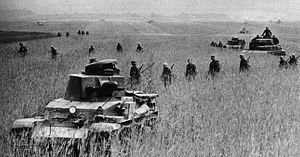Today, Michael Carl Haas published a fascinating rebuttal to an article I discussed and recommended last month (“The One Article To Read on Chinese Naval Strategy in 2015”).
In his piece, Haas criticizes the authors of “Projecting Strategy: The Myth of Chinese Counter-intervention” for a too literal interpretation of officially sanctioned Chinese texts, and argues that the two professors, “most certainly underestimate the factual prominence of A2/AD-like precepts in Chinese military planning.” He also notes that the refutation of counter-intervention as a concept, should not be equated with refuting “counter-intervention” in substance, i.e. the absence of an official written doctrine does not mean that it will not be used in the event of war with the United States or Japan.
I think this is a valid point. For example, the absence of the term Blitzkrieg or its equivalent in German military literature prior to the Second World War didn’t mean that German military strategists were not planning for a swift strategic knockout blow of the enemy in the event of war. They obviously did, only there was no coherent German strategy written down on the subject prior to the beginning of hostilities in 1939.
However, for me, the most important takeaway from Fravel and Twomey’s article remains the concluding statement that, “history has shown—both in general and in previous U.S.–China cases specifically—that countries tend to evaluate their opponents through a ‘military lens’ that is heavily shaped by their own traditions and doctrines. It is critical for the United States to avoid this making this mistake (again).”
Prior to 1940, French generals reached the conclusion that the Wehrmacht would try to attempt a breakthrough by concentrating their armored forces. However, the firm belief that they had figured out German operational doctrine made the French high command dogmatic, and they dismissed the possibility that an armored column could break through terrain unsuitable for tanks. Therefore, once the battle began, the elite French tank forces concentrated in the North of France and in Belgium and no contingency plans were made for an enemy breakthrough in the South (The Belgians correctly assessed that the major armored thrust would be made through the Ardennes, yet the French ignored this analysis).
In other words, the French evaluated their opponents through a “military lens” shaped by their own tactical and operational methodology, which called for tank-on-tank warfare in Belgium, where superior French armor could be brought to bear and where the massed German tank formations could not exploit their superior maneuverability. All of this happened, despite the French correctly guessing the Wehrmacht’s operational doctrine.
What does this mean for the current debate over the myth of Chinese counter-intervention? In short, correctly assessing an opponents operational doctrine is only half the battle. The other half is to continuously evaluate and question one’s most basic assumptions about the enemy in order to detect blind spots in one’s thinking.
Anyone studying the Chinese military knows that the PLA is seeing a conflict with the United States through an anti-access and area denial lens. The PLA is exploring asymmetrical advantages in the face of the U.S. conventional superiority and, according to Sam J. Tangredi in Anti-Access Warfare, is convinced, that “even an adversary with superior weapons, technology, and equipment will be unable to maintain absolute superiority in all respects.”
It is therefore reasonable to assume that the PLA is probing American relative weaknesses (e.g., the U.S.’s overreliance on satellite technology) and that China invests in means to exploit these weak spots. “Chinese strategists appear to understand that success against the U.S. military depends on China’s ability to avoid a direct confrontation with U.S. forces in a traditional force-on-force battle,” a RAND study notes. A counter-intervention strategy would certainly meet this requirement.
Yet, even if we are correctly analyzing the PLA’s A2/AD strategy in a future conflict with the United States or Japan, we have to be careful not to fall into the “military lens”/mirror imaging analytical trap outlined above (e.g., How much does the new “Joint Concept for Access and Maneuver in the Global Commons” reflect American desires of how a confrontation between the U.S. and the PRC should play out rather than the likely reality?). In that sense, Haas’ article is a nice supplement to Fravel and Twomey’s publication. Both pieces make us reevaluate and revisit some fundamental assumptions about an alleged critical component of Chinese military thought – and that is a good thing.

































